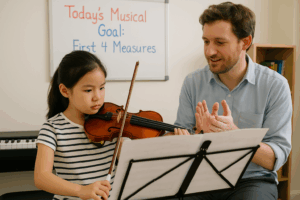We’ve all been there—a student hears a challenging piece and wants to play it right now. As private music teachers working with younger students, we love that enthusiasm. But we also know that teaching complex music to beginners requires patience, smart planning, and plenty of creativity.
The goal isn’t to say “you’re not ready.” Instead, we show students that they can tackle big goals—by learning to take things one step at a time.
Why Introduce Difficult Music at All?
Some teachers avoid harder music for young beginners, but we believe in exposure. When handled carefully, complex music can:
- Spark long-term motivation
- Build problem-solving skills
- Show students what’s possible with practice
- Deepen listening and musical curiosity
That said, how we present it makes all the difference.
4 Ways to Make Challenging Music Accessible
1. Break It Into Bite-Sized Pieces
Instead of playing the full page, focus on:
- One hand at a time (if piano)
- A single phrase or motif
- The rhythm only—no pitches yet
- Just the first two measures
You might teach it like a puzzle: build the edges, then fill in the middle.
2. Simplify Without Dumbing Down
You can modify a difficult passage without losing its spirit. Try:
- Using simplified rhythms
- Removing accidentals temporarily
- Playing at half speed
- Singing the melody before playing
Many young musicians thrive when they’re taught the “essence” of a piece first.
3. Use the Music as a Listening Goal
Even if a student isn’t ready to play a full piece, they can:
- Listen to recordings
- Identify repeated themes
- Tap along with rhythms
- Talk about how it makes them feel
Want more tips on listening activities? Explore our post on playing music by ear.
4. Celebrate the Process
When a child tackles something tough, even a few notes of success should be praised. This builds confidence and shows that growth matters more than perfection.
What Research Says About Scaffolded Learning
According to Harvard’s Project Zero, children learn best when material is “just beyond” their current skill level—what educators call the zone of proximal development. Carefully introducing more difficult material, with guidance, helps students stretch without overwhelming them.
FAQ: Working With Challenging Music
Is it okay if my child doesn’t master the whole piece?
Absolutely. Even playing one phrase well builds skills and confidence. The goal is growth, not perfection.
Should we stick with easier pieces instead?
It’s great to mix both! Easier pieces help reinforce skills, while more challenging ones build resilience and curiosity.
How can I support practice at home?
Ask your child to show you one “cool part” they worked on. Praise the effort, not the outcome.
